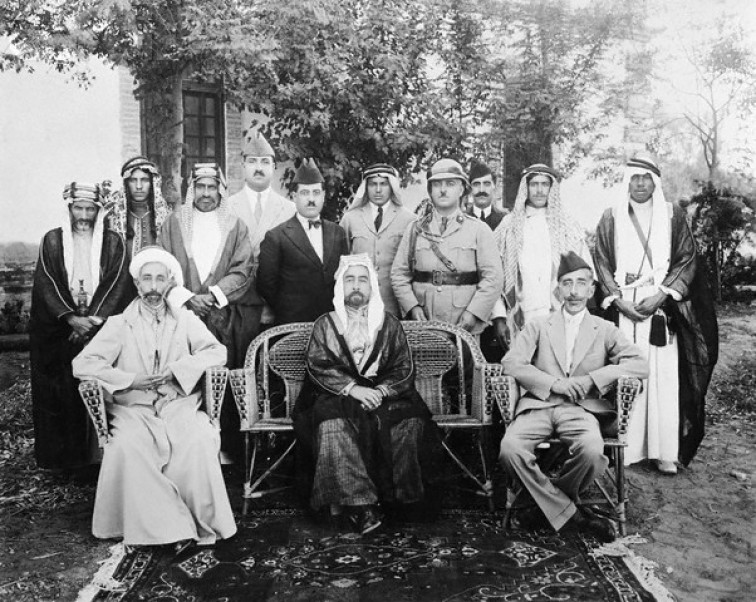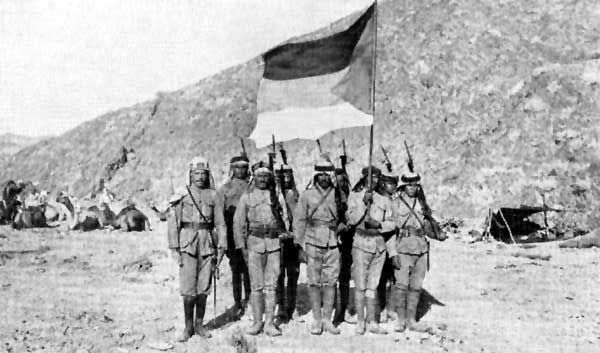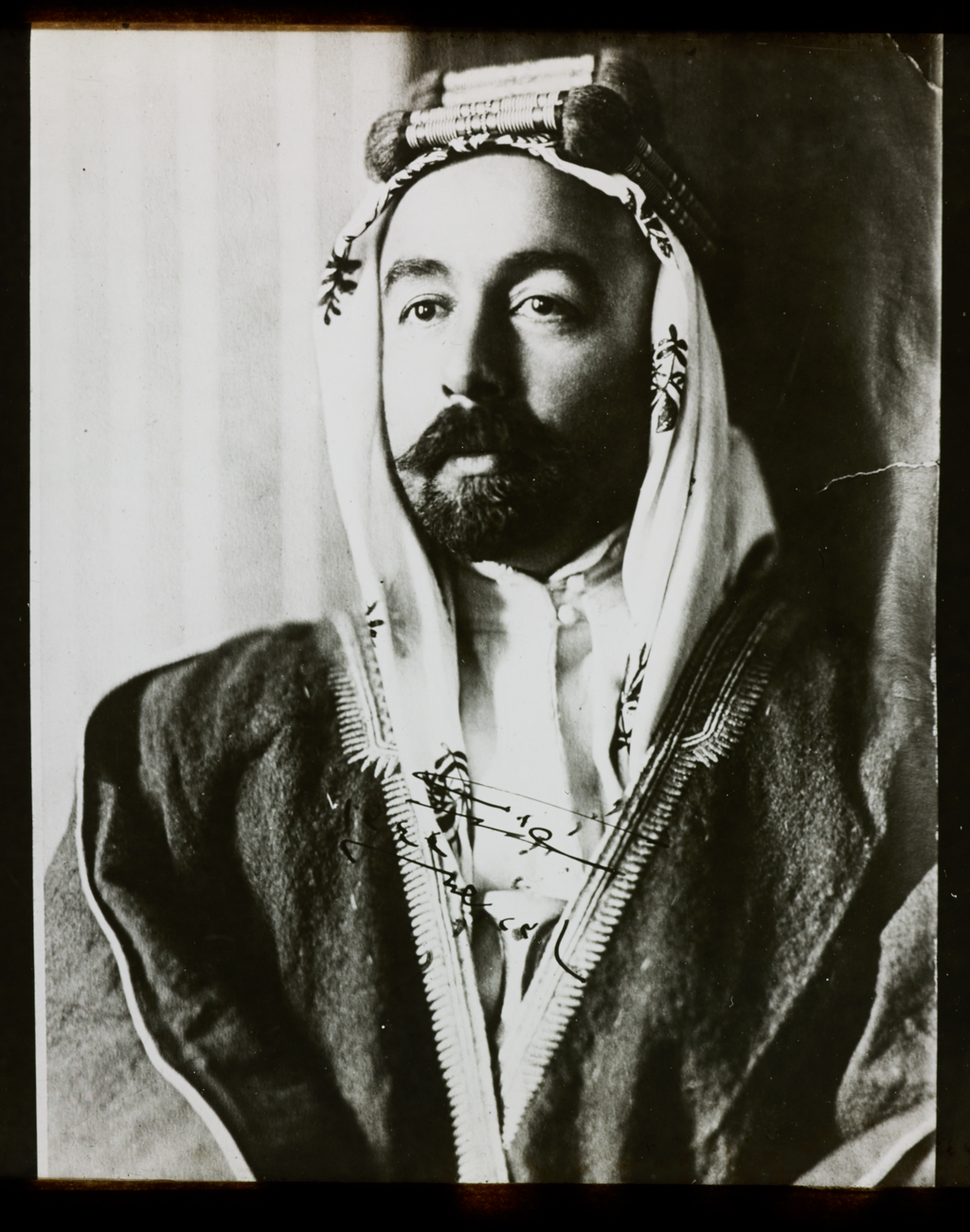|
King Abdullah I
Abdullah I (Abdullah bin Hussein; 2 February 188220 July 1951) was the ruler of Jordan and its predecessor state Transjordan from 1921 until his assassination in 1951. He was the Emir of Transjordan, a British protectorate, until 1946, when he became king of an independent Transjordan (shortened to Jordan in 1949). As a member of the Hashemite dynasty, the royal family of Jordan since 1921, Abdullah was a 38th-generation direct descendant of Muhammad. Born in Mecca, Hejaz, Ottoman Empire, Abdullah was the second of four sons of Hussein bin Ali, Sharif of Mecca, and his first wife, Abdiyya bint Abdullah. He was educated in Istanbul and Hejaz. From 1909 to 1914, Abdullah sat in the Ottoman legislature, as deputy for Mecca, but allied with Britain during the First World War. During the war, he played a key role in secret negotiations with the United Kingdom that led to the Great Arab Revolt against Ottoman rule that was led by his father Sharif Hussein.Encyclopaedia Britannica ... [...More Info...] [...Related Items...] OR: [Wikipedia] [Google] [Baidu] |
Talal Of Jordan
Talal bin Abdullah (26 February 1909 – 7 July 1972) was King of Jordan from the assassination of his father, King Abdullah I, on 1951 until his forced abdication in 1952. He was a member of the Hashemite dynasty. Talal was born in Mecca as the eldest son of Abdullah bin Hussein and his wife Musbah bint Nasser. Abdullah was a son of Sharif Hussein of Mecca, who led the Great Arab Revolt during World War I against the Ottoman Empire in 1916. After removing Ottoman rule, Abdullah established the Emirate of Transjordan in 1921, and ruled as its Emir. During Abdullah's absence, Talal spent his early years alone with his mother. Talal received private education in Amman, later joining Transjordan's Arab Legion as second lieutenant in 1927. He then became aide to his grandfather Sharif Hussein, the ousted king of the Hejaz, during his exile in Cyprus. By 1948, Talal became a general in the Arab Legion. The country sought independence in 1946, and the Emirate became the Hashemite ... [...More Info...] [...Related Items...] OR: [Wikipedia] [Google] [Baidu] |
King Of Jordan
The king of the Hashemite Kingdom of Jordan () is the monarchical head of state of Jordan. He serves as the head of the Jordanian monarchy—the Hashemites, Hashemite dynasty. The king is addressed as Majesty, His Majesty (). Jordan is a constitutional monarchy. However, the king is vested with somewhat more executive and legislative power than is typically the case for constitutional monarchs. He is commander-in-chief of the Jordanian Armed Forces and appoints the Prime Minister of Jordan and the directors of security agencies. He also appoints the members of the upper house, the Senate (Jordan), Senate, as well as the members of the Constitutional Court. The current king, Abdullah II of Jordan, Abdullah II, took the throne on 7 February 1999 following the death of his father, Hussein of Jordan, Hussein. History The sons of Hussein bin Ali, King of Hejaz, Hussein bin Ali, the Sharif of Mecca, Grand Emir and Sharif of Mecca were set up as the List of kings of Iraq, kings of I ... [...More Info...] [...Related Items...] OR: [Wikipedia] [Google] [Baidu] |
Arab Revolt
The Arab Revolt ( ), also known as the Great Arab Revolt ( ), was an armed uprising by the Hashemite-led Arabs of the Hejaz against the Ottoman Empire amidst the Middle Eastern theatre of World War I. On the basis of the McMahon–Hussein Correspondence, exchanged between Henry McMahon of the United Kingdom and Hussein bin Ali of the Kingdom of Hejaz, the rebellion against the ruling Turks was officially initiated at Mecca on 10 June 1916. The primary goal of the Arab rebels was to establish an independent and unified Arab state stretching from Aleppo to Aden, which the British government had promised to recognize. The Sharifian Army, led by Hussein and the Hashemites with backing from the British military's Egyptian Expeditionary Force, successfully fought and expelled the Ottoman military presence from much of the Hejaz and Transjordan. By 1918, the rebels had captured Damascus and proclaimed the Arab Kingdom of Syria, a short-lived monarchy that was led by Hussein ... [...More Info...] [...Related Items...] OR: [Wikipedia] [Google] [Baidu] |
Royal Jordanian Army
The Royal Jordanian Army (Arabic: اَلْقُوَّاتُ ٱلْبَرِّيَّةُ ٱلْأُرْدُنِيَّةُ; ) is the ground force branch of the Jordanian Armed Forces (JAF). It draws its origins from units such as the Arab Legion, formed in the British Mandate of Transjordan in the 1920s. It has seen combat against Israel in 1948, 1956, 1967, and 1973. The Army also fought the Syrians and the PLO during Black September in 1970. History Origins – 1920–1947 On 10 June 1916, Sherif Hussien Bin Ali prince of Mecca, officially declared the Great Arab Revolt against the Ottoman Empire to rid Arab nations of the Turkish rule that had lasted about four centuries. On 21 November 1920, Prince Abdullah Bin Al-Hussien (later King) arrived at Ma'an, where he expressed his resolution to drive out the Turkish forces from Syria. Later, on 5 December 1920, he proclaimed himself as deputy king in Syria and appealed to members of the Al-Faissali army to join his forc ... [...More Info...] [...Related Items...] OR: [Wikipedia] [Google] [Baidu] |
Arab Legion
The Arab Legion () was the police force, then regular army, of the Emirate of Transjordan, a British protectorate, in the early part of the 20th century, and then of the Jordan, Hashemite Kingdom of Jordan, an independent state, with a final Arabization of its command taking place in 1956, when British senior officers were replaced by Jordanian ones. Creation In October 1920, after taking over the Transjordan region from the Ottoman Empire, Ottomans, the United Kingdom formed a unit of 150 men called the "Mobile Force", under the command of Captain Frederick Gerard Peake, to defend the territory against both internal and external threats. The Mobile Force was based in Zarqa. 80% of its men were drawn from the Chechens in Jordan, local Chechen community. It was quickly expanded to 1,000 men, recruiting Arabs who had served in the Ottoman Army (1861–1922), Ottoman Army. On 22 October 1923, the police were merged with the Reserve Mobile Force, still under Peake, who was now an ... [...More Info...] [...Related Items...] OR: [Wikipedia] [Google] [Baidu] |
Sunni Islam
Sunni Islam is the largest Islamic schools and branches, branch of Islam and the largest religious denomination in the world. It holds that Muhammad did not appoint any Succession to Muhammad, successor and that his closest companion Abu Bakr () rightfully succeeded him as the caliph of the Muslim community, being appointed at the meeting of Saqifa. This contrasts with the Succession of ʿAlī (Shia Islam), Shia view, which holds that Muhammad appointed Ali, Ali ibn Abi Talib () as his successor. Nevertheless, Sunnis revere Ali, along with Abu Bakr, Umar () and Uthman () as 'Rashidun, rightly-guided caliphs'. The term means those who observe the , the practices of Muhammad. The Quran, together with hadith (especially the Six Books) and (scholarly consensus), form the basis of all Fiqh, traditional jurisprudence within Sunni Islam. Sharia legal rulings are derived from these basic sources, in conjunction with Istislah, consideration of Maslaha, public welfare and Istihsan, jur ... [...More Info...] [...Related Items...] OR: [Wikipedia] [Google] [Baidu] |
Hussein Bin Ali, King Of Hejaz
Hussein bin Ali al-Hashimi ( ; 1 May 18544 June 1931) was an Arab leader from the Banu Qatadah branch of the Banu Hashim clan who was the Sharif and Emir of Mecca from 1908 and, after proclaiming the Great Arab Revolt against the Ottoman Empire, King of the Hejaz, even if he refused this title,Representation Of Hedjaz At The Peace Conference: Hussein Bin Ali's Correspondence With Colonel Wilson; Status Of Arabic Countries; King's Rejection Of 'Hedjaz' Title. Paris Peace Conference 1919: Representation Of Hedjaz, Feb. 24, 1919, Manuscript Number FO 608/97-0068 The National Archives (Kew, United Kingdom) from 1916 to 1924. He proclaimed himself Caliph after the abolition of the Ottoman Caliphate in 1924 and stayed in power until 1925 when Hejaz was invaded by the Saudis. His Caliphate was opposed by the British and French empires, the Zionists and the Wahhabis alike. However, he received support from a large part of the Muslim population of that time. and from Mehmed VI.C ... [...More Info...] [...Related Items...] OR: [Wikipedia] [Google] [Baidu] |
Hashemite
The Hashemites (), also House of Hashim, are the Dynasty, royal family of Jordan, which they have ruled since 1921, and were the royal family of the kingdoms of Kingdom of Hejaz, Hejaz (1916–1925), Arab Kingdom of Syria, Syria (1920), and Kingdom of Iraq, Iraq (1921–1958). The family had ruled the city of Mecca continuously from the 10th century, primarily as vassals of outside powers, and ruled the thrones of the Hejaz, Syria, Iraq, and Jordan following their World War I alliance with the British Empire. The family belongs to the Dhawu Awn, one of the branches of the Hasanids, Ḥasanid Sharifs of Mecca, also referred to as Hashemites. Their eponymous ancestor is traditionally considered to be Hashim ibn Abd Manaf, great-grandfather of the Islamic prophet Muhammad. Another claimed ancestor is Ali ibn Abi Talib, the usurped successor of the prophet Muhammad according to Shia Islam. The Ḥasanid Sharifs of Mecca (from whom the Hashemite royal family is directly descended), inc ... [...More Info...] [...Related Items...] OR: [Wikipedia] [Google] [Baidu] |
Prince Nayef Bin Abdullah
Prince Nayef bin Abdullah (, ''al-Amir Nayif ibn ʿAbd Allāh''; 14 November 1914 – 12 October 1983) was the younger son of King Abdullah I of Jordan, by his second wife, Suzdil Khanum. As a member of the Hashemite dynasty, the royal family of Jordan since 1921, Nayef was a 39th-generation direct descendant of Muhammad. Nayef attended Victoria College in Alexandria. He underwent Military training in Turkey, being assigned as the honorary Aide-de-Camp of the Turkish President Ismet Inönü between April 1939 until shortly before the outbreak of World War II in September the same year. He became regent of Jordan on 20 July 1951, following the assassination of Abdullah, because his older half-brother King Talal was reportedly suffering from poor health. Nayef ruled in his brother's stead until 6 September 1951, when Talal was judged fit to assume his royal duties. Nayef died in Jordan on 12 October 1983. Honours * Knight Grand Cordon (Special Class) of the Supreme Order o ... [...More Info...] [...Related Items...] OR: [Wikipedia] [Google] [Baidu] |
Khanum
Khanum, Hanum, Hanım, Hanem, Khanom, or Khanoum (Uzbek language, Uzbek: Xonim/Хоним, , Mongolian language, Mongolian: Ханым, , , , , , , ) is a female royal family, royal and aristocracy, aristocratic title that was originally derived through a Central Asian title, and later used in the Middle East and South Asia. It is the Femininity, feminine equivalent of the title ''Khan (title), Khan'' for a sovereign or military ruler, widely used by medieval nomadic Turkic peoples living in Asia and Europe and also Proto-Mongols, Mongol tribes living north and northwest of modern-day China. In the construction of words of the Turkic languages, the suffix "-''um / -ım''" adds "''my''", making the word "Khanum" as "my Khan". This arises from the tale, depicting a Khan announcing to his subjects ''I am your Khan, and She is my Khan (Khanum)''. "Khan" is also seen as a title in the Xianbei confederationHenning, W. B., 'A Farewell to the Khagan of the Aq-Aqataran',"Bulletin of the Scho ... [...More Info...] [...Related Items...] OR: [Wikipedia] [Google] [Baidu] |





